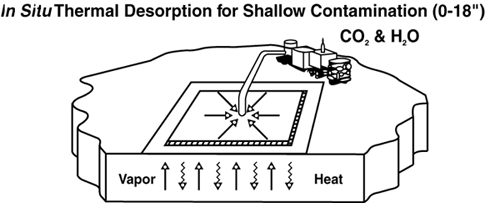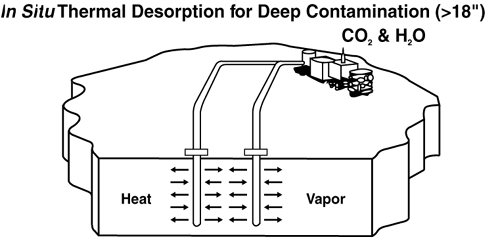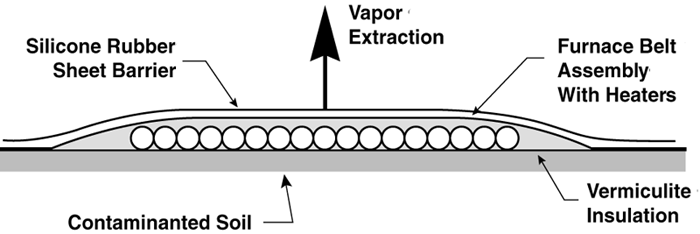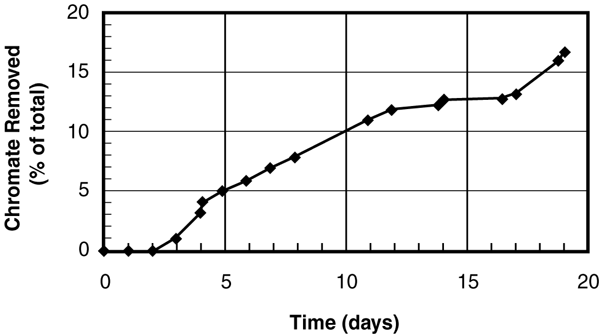February 1998
Heating Technologies and SVE in Hydraulic Fractures to Remove Hydrocarbon Fuels
by Kathy Balshaw-Biddle, AATDF
Recent field testing under the Advanced Applied Technology Development Facility (AATDF) program at Rice University showed effective removal of JP-8 jet fuel from tight clay soils through the use of hydraulic fracturing, steam injection or electro-heating, and soil vapor extraction (SVE). Soil heating reduced total petroleum hydrocarbons (TPH) concentrations to less than 250 mg/kg, which is below target levels. This remediation technology project is one of 12 that have been field-tested through the U.S. Department of Defense AATDF program.
The test site is located adjacent to a tank farm on the Robert Gray Army Airfield, Fort Hood, TX. Underlying soil consists of argillaceous limestone and calcareous clay with some oyster shells. Shallow ground water in the area is unconfined and flows through clay fractures. Hydraulic conductivity in soil samples ranges from 3.3 x 10-8 to 2.1 x 10-9 cm/sec. Separate phase hydrocarbons were identified up to 4.8 feet in thickness in monitoring wells prior to remediation. TPH concentrations in soil samples before treatment were as high as 35,500 mg/kg, and concentrations greater than 1,000 mg/kg occurred consistently between the depths of 10-20 feet.
The initial remediation strategy included hydraulic fracturing followed by steam injection in three 25 x 25-foot test cells. The fractures were mapped using soil borings, and the heating and SVE wells were installed to intersect the fracture. Field evaluation determined that the radial size and lateral continuity of the fractures were not sufficient in two of the three test cells to allow effective steam injection. The original strategy was then modified to include a comparison of electro-heating [alternating current (AC)] and steam injection in the two moderately fractured cells.
Comparison of the pre-fracture and post-fracture permeabilities in the soil was affected negatively by heavy rains. Pre-fracture vent testing on relatively dry clay soil indicated an air permeability of approximately 4.9 x 10-9 cm2. Post-fracture vent testing occurred after five intervening months of unexpectedly heavy rains during which the water table rose 8-10 feet and had to be pumped back down in the test cells. The post-fracture air permeability of the water-saturated clay soils was approximately 2.9 x 10-9 cm2, probably related to hydration of the clay soil.
Steam-enhanced hydrocarbon recovery at the Fort Hood site produced maximum soil temperatures of 180-200°F. (Soil temperature generally depends on steam injection pressure (typically 5-20 psi), which is a function of the soil type and depth of the target zone.) Injection of steam into the hydraulically fractured clay transferred heat to the soil via both convection along fractures and intersecting discontinuities, and conduction to clays adjacent to the fractures. Latent heat of condensation from the steam increased the vapor pressure and volatilization rate of volatile and semi-volatile constituents of the JP-8 jet fuel. Increased temperatures also enhanced fluid mobility of semi-volatile constituents. The system produced a large volume of vapors, mobile TPH, and condensate that were removed using SVE and ground water extraction.
The electro-heating technology used at Fort Hood employed a combination of multiphase electric heating and SVE extraction, with six electrodes and electrodic irrigation (water drip into the electrode’s carbon matrix to maintain soil moisture) installed in a hexagonal array to deliver 3-phase AC power to the soil. The 3-phase current consisted of three voltage sources having the same amplitude and frequency but displaced from each other by 120 degrees. Heat in the AC cells was not dependent upon SVE operation or dewatering, but occurred more slowly than in the steam cell. Heating was less effective in areas where inadequate hydraulic fracturing hampered both steam injection and water extraction from the soil.
Overall, preliminary mass removal rates in the steam-heating cell were an order of magnitude higher than in the electrode-heating cell. The AATDF is issuing a final report on this demonstration in early 1998. For more information, contact Kathy Balshaw-Biddle (AATDF) by fax at 713-285-5948. Project information is available on the AATDF internet site (www.ruf.rice.edu/~AATDF/index.htm).
In Situ Thermal Blankets and Wells for PCB Removal in Tight Clay Soils
by Pauletta France-Isetts, EPA Region 7
A recent field demonstration conducted at the Missouri Electric Works (MEW), Cape Girardeau, MO, Superfund site indicated that a new in situ thermal desorption (ISTD) process can reduce concentrations of polychlorinated biphenyls (PCBs) in tight clay soils to non-detect levels of less than 33 ppb. The ISTD process employed thermal blankets to remove contaminants from soil at shallow depths (0-18 inches) and thermal wells for removal at lower depths. The PCB (Aroclor 1260) destruction and removal efficiency (DRE) for both tests at the MEW site was greater than “six nines” (>99.9999%).
Both the ISTD-thermal blanket and ISTD-thermal well technologies employ a fundamental process involving heat flow, fluid flow, phase behavior, and chemical reactions (as shown in Figures 1 and 2). In each form of the ISTD process, heat is applied to soil from a high-temperature surface in contact with the soil, thereby allowing for effective radiation and thermal conduction heat transfer near the heat source, and thermal conduction and convection in the bulk of the soil volume. Thermal conduction accounts for over 80% of the heat transfer. A very high temperature (>1,000°F) is created near the heat source, which causes rapid destruction of the contaminants before they exit the soil. (Aroclor 1260, which was removed at the MEW site, has a boiling point range of 720-780°F, the highest of all PCBs.)
| Figure 1: ISTD-Thermal Blankets
|
Figure 2: ISTD-Thermal Wells
|
The ISTD-thermal blanket (Figure 3) is an 8-foot by 20-foot steel box covering 160 square feet of 100-kw heating rods that raise near-surface soil temperatures to 1,400-1,600°F. Thermal monitoring devices (thermocouples) are installed at the ground surface and at various depths to monitor spatial heating of the treatment area. Multiple blankets are installed next to one another to treat large areas. Heating elements are covered by a 12-inch-thick thermal insulation layer, which reduces upward heat loss to less than 10%. A barrier is installed over the insulated blanket frame and vapors are collected. High temperatures near the heating elements convert the majority of contaminants to CO2 and water vapor.
| Figure 3: Cross-Section of ISTD-Thermal Blanket
|
The ISTD-thermal well process utilizes an array of heater/vacuum wells emplaced vertically in the ground in triangular patterns. The wells are equipped with high-temperature electric heaters and connected to a vacuum blower. As heat is injected and soil temperatures rise (to 1,400-1,600°F near the wells and >1,000°F between the wells), the vaporized formation fluids, including contaminants, are collected by the vacuum drawn at the wells. Off-gases are treated in surface facilities to remove residual contaminants that have not been destroyed in situ.
At the MEW site, two heater blankets were emplaced and 12 heater/vacuum wells were constructed in a multiple triangular array with a 5-foot well spacing to a depth of 12 feet. The demonstration consisted of soil heating and vacuum extraction of vapors for 42 days. Temperatures above 1000°F were achieved in the interwell regions. PCB concentrations in the treated area were reduced from a maximum concentration of 20,000 ppm to less than 33 ppb. Peak and continuous emission monitoring by a mobile process unit ensured that the discharge of PCBs and combustion byproducts resulting from treatment complied with ambient air requirements. The off-gas treatment system consisted of a flameless thermal oxidizer with >99.99% DRE, followed by two carbon beds in series.
Hydrogen chloride (HCl) stack emissions, which are byproducts of PCB conversion, were used to monitor stack emissions and indicate when the remediation process was complete. Although the majority of HCl reacted at high temperatures with the iron and carbonate minerals in the soil, limestone was used in treatment carbon beds as an additional scrubber. Emission stack sampling by EPA methods demonstrated that the discharge of PCBs and combustion byproducts complied with state and federal ambient air requirements.
For more information on the MEW demonstration, contact Pauletta France-Isetts (EPA Region 7) at 913-551-7701.
Feasibility Study on Electrokinetic Processing Systems
EPA initiated a 3-part study on the feasibility of using electrokinetic processing systems to remediate radioactive and hazardous mixed wastes. The first part of the study resulted in a resource document entitled, “Electrokinetic Laboratory and Field Processes Applicable to Radioactive and Hazardous Mixed Waste in Soil and Groundwater from 1992 to 1997” (publication # EPA-402-R-97-006). The document lists and describes all published work on electrokinetic remediation conducted between 1992 and 1997. This work includes electrokinetic remediation used commercially or on a conceptual, bench, pilot, or field scale. Resource information includes the technology developers’ name and address, technical description, status, cost, and illustration (if available). This resource document may be downloaded from the Internet at http://www.epa.gov/radiation/technology/rttcpubs.htm.
In the second part of the feasibility study, researchers will collect radioactive and hazardous mixed waste soil samples from a selected U.S. Department of Energy (DOE) facility. An electrokinetic facility at DOE’s Idaho National Engineering Laboratory will conduct a bench-scale analysis of the applicability of electrokinetic processing to the collected soil samples. If bench-scale analysis proves successful, part 3 of the feasibility study will consist of a field demonstration at the DOE site. Contact Robin Anderson (EPA Office of Radiation and Indoor Air) at 202-564-9385 for additional information.
In Situ Electroremediation of Chromate- Contaminated Soil
by Ronald F. Probstein, Ph.D., MIT
Preliminary results from field tests initiated in December 1997 at a Jersey City, NJ, landfill indicate that in situ electroremediation effectively removes hexavalent chromium in the form of chromate from unsaturated soils. The removal rate per operating day is averaging about one percent of the 5,000 ppm of the mean chromate concentration found at the test site (see Figure 4). Continuous monitoring and adjustments of the electrokinetics-based process are underway to achieve an average daily removal rate of 2% of the chromate found at the test site. Researchers from the Massachusetts Institute of Technology (MIT), Corrpro Companies, Inc., and EPA Region 2 are collaborating on this project, which is sponsored by the Northeast Hazardous Substance Research Center.
| Figure 4: Percent of Chromate in Soil Removed as a Function of Operating Time
|
In electroremediation, contaminants are removed from soil under the action of an electric field. A direct-current potential applied across pairs of electrodes placed in the soil causes dissolved chromate ions in the pore liquid to move toward the anode by the process of ionic migration. Once contaminants are at the electrode well, they are dissolved and pumped to the surface.
The Jersey City field tests are based on the findings of earlier laboratory studies and computer modeling. The test site is a 6 x 12-foot plot extending to the depth of the water table (approximately 6 feet below ground surface). The site as originally configured contains a rectangular electrode array of 18 cathodes and 5 anodes. The cathodes are 6 foot-long, 0.5 inch-diameter rods driven into the soil on 2-foot centers around the periphery of the treatment area. The iron-pipe anodes are contained in wells that accommodate recirculating purge solution and serve as a sink for the chromate ions.
The system’s purge solution is continuously recirculated between the anode chambers and a treatment drum, where the pH is checked and adjusted as required. Precipitating agents are added to the purge solution and will be disposed as a hazardous waste at the conclusion of the test demonstration. A diaphragm pump provides the suction needed to draw the pure solution from the anode wells, pull in the solution from the treatment drum, and maintain a slight vacuum to prevent loss of liquid into the soil through the porous walls of the well.
During 1998, researchers will design field demonstrations using the results of these field tests. Process variables will address data collected on relationships among the rate of dissolution, solubility limit, pH, temperature, and background electrolyte composition, and will reflect computer model refinements.
Researchers also have found that variations of this technology are successful for application in fully saturated soils and ground waters and for other waste types, including radionuclides and soluble organics. For more information, contact Dr. Ronald Probstein (MIT) at 617-253-2240.
| We now offer a new service-TechDirect-to keep you abreast of new EPA publications and event of interest to site remediation and site characterization professionals. Once a month, a TechDirect message will be sent via email describing new products and instructions on how to obtain them. |
| WE ARE TRYING TO SAVE TREES
AND POSTAGE!
|










